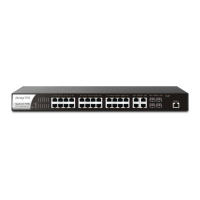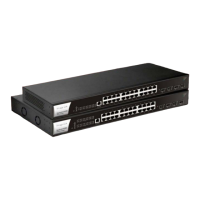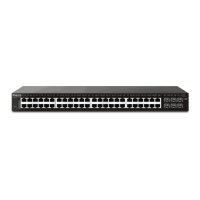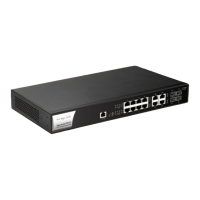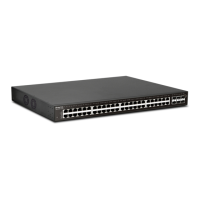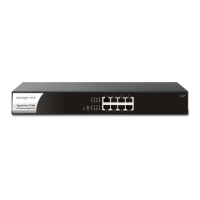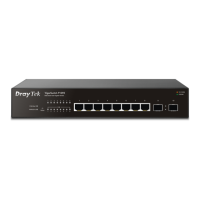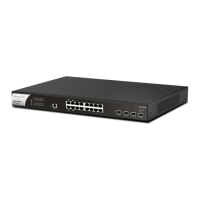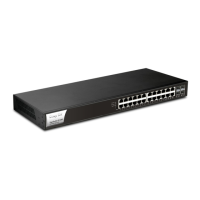Do you have a question about the Draytek VigorSwitch P2261 and is the answer not in the manual?
Provides step-by-step instructions for installing the switch, including SFP modules and rack mounting.
Guides on how to correctly install SFP fiber transceivers into the switch chassis for network connectivity.
Explains how to set up the switch's IP address and access its management agent through an Ethernet port.
Introduces the web-based management interface and provides an overview of the switch's system information displayed upon login.
Covers essential system information such as device name, uptime, firmware version, and hardware details.
Provides a detailed breakdown of system parameters, including model name, system description, contact, and date.
Manages user accounts, allowing creation, modification, and deletion of usernames and passwords with privilege levels.
Configures the switch's IPv4 address, subnet mask, default gateway, and DNS server settings for network communication.
Allows configuration of IPv6 addresses, prefixes, and gateway settings for network connectivity using the IPv6 protocol.
Offers extensive configuration options for managing the switch's network features and protocols.
Configures link aggregation using static trunks to bundle multiple ports for increased bandwidth and redundancy.
Sets up Link Aggregation Control Protocol (LACP) for forming logical trunked ports, enhancing reliability and bandwidth.
Configures Spanning Tree Protocol (STP) settings to detect and prevent network loops, ensuring a stable network topology.
Configures basic IGMP snooping settings to optimize multicast traffic forwarding and manage bandwidth efficiently.
Configures MLD snooping for IPv6 multicast traffic, minimizing unnecessary traffic by forwarding only to ports with MLD hosts.
Configures Link Layer Discovery Protocol (LLDP) settings for network discovery and device information exchange.
Configures LLDP-MED for VoIP devices, enabling auto-discovery of LAN policies and power management.
Configures Power over Ethernet (PoE) port settings, managing power delivery to connected devices.
Shows the current status of all PoE ports, including power requested, allocated, and used by connected devices.
Manages the MAC Address Table, configuring aging times for dynamic entries and static MAC learning.
Configures VLAN memberships and port assignments, managing VLAN isolation and port inclusion.
Sets up VLAN tag rules, ingress filtering, frame types, egress rules, and port roles (Access, Trunk, Hybrid).
Configures MAC-based VLANs to assign VLAN tags based on source MAC addresses for secure network access.
Configures Voice VLAN settings to prioritize voice traffic, ensuring quality of service for VoIP devices.
Configures Quality of Service (QoS) ingress classification rules to prioritize and manage network traffic based on various criteria.
Configures QoS Port DSCP configuration for ingress and egress translation and classification of traffic.
Defines QoS Control Lists (QCL) to specify frame matching criteria and actions like class, DPL, and DSCP for traffic management.
Covers various security features, including Access Control Lists (ACL), IP Source Guard, ARP Inspection, and authentication methods.
Configures Access Control List (ACL) parameters for each switch port to filter and manage network traffic based on defined policies.
Defines Access Control List (ACL) rules, specifying permit/deny conditions for IP addresses, MAC addresses, and frame types.
Configures IP Source Guard to prevent IP spoofing by validating source IP and MAC addresses on ports.
Configures ARP Inspection parameters to prevent ARP spoofing attacks and ensure network integrity.
Configures DHCP Snooping to prevent unauthorized DHCP servers from operating on the network, enhancing security.
Configures Network Access Server (NAS) parameters, including IEEE 802.1X and MAC-based authentication system settings.
Configures AAA (Authentication, Authorization, Accounting) server settings, including RADIUS and TACACS+ for network access control.
Configures Port Security to restrict interface access by limiting and identifying MAC addresses, preventing unauthorized devices.
Configures access management for HTTP/HTTPS, SNMP, and TELNET/SSH, controlling network access to the switch.
Covers essential maintenance tasks such as device restart, firmware upgrades, save/restore configurations, and diagnostics.
Guides on upgrading the switch's firmware to enhance functionality and performance with new features.
Uses the Ping utility to diagnose network connectivity issues by sending ICMP packets to specified IP addresses.
Utilizes the Ping6 utility for troubleshooting IPv6 connectivity issues by sending ICMPv6 packets.
Addresses common causes for a missing link LED status, helping to diagnose connectivity problems.
Provides step-by-step instructions for installing the switch, including SFP modules and rack mounting.
Guides on how to correctly install SFP fiber transceivers into the switch chassis for network connectivity.
Explains how to set up the switch's IP address and access its management agent through an Ethernet port.
Introduces the web-based management interface and provides an overview of the switch's system information displayed upon login.
Covers essential system information such as device name, uptime, firmware version, and hardware details.
Provides a detailed breakdown of system parameters, including model name, system description, contact, and date.
Manages user accounts, allowing creation, modification, and deletion of usernames and passwords with privilege levels.
Configures the switch's IPv4 address, subnet mask, default gateway, and DNS server settings for network communication.
Allows configuration of IPv6 addresses, prefixes, and gateway settings for network connectivity using the IPv6 protocol.
Offers extensive configuration options for managing the switch's network features and protocols.
Configures link aggregation using static trunks to bundle multiple ports for increased bandwidth and redundancy.
Sets up Link Aggregation Control Protocol (LACP) for forming logical trunked ports, enhancing reliability and bandwidth.
Configures Spanning Tree Protocol (STP) settings to detect and prevent network loops, ensuring a stable network topology.
Configures basic IGMP snooping settings to optimize multicast traffic forwarding and manage bandwidth efficiently.
Configures MLD snooping for IPv6 multicast traffic, minimizing unnecessary traffic by forwarding only to ports with MLD hosts.
Configures Link Layer Discovery Protocol (LLDP) settings for network discovery and device information exchange.
Configures LLDP-MED for VoIP devices, enabling auto-discovery of LAN policies and power management.
Configures Power over Ethernet (PoE) port settings, managing power delivery to connected devices.
Shows the current status of all PoE ports, including power requested, allocated, and used by connected devices.
Manages the MAC Address Table, configuring aging times for dynamic entries and static MAC learning.
Configures VLAN memberships and port assignments, managing VLAN isolation and port inclusion.
Sets up VLAN tag rules, ingress filtering, frame types, egress rules, and port roles (Access, Trunk, Hybrid).
Configures MAC-based VLANs to assign VLAN tags based on source MAC addresses for secure network access.
Configures Voice VLAN settings to prioritize voice traffic, ensuring quality of service for VoIP devices.
Configures Quality of Service (QoS) ingress classification rules to prioritize and manage network traffic based on various criteria.
Configures QoS Port DSCP configuration for ingress and egress translation and classification of traffic.
Defines QoS Control Lists (QCL) to specify frame matching criteria and actions like class, DPL, and DSCP for traffic management.
Covers various security features, including Access Control Lists (ACL), IP Source Guard, ARP Inspection, and authentication methods.
Configures Access Control List (ACL) parameters for each switch port to filter and manage network traffic based on defined policies.
Defines Access Control List (ACL) rules, specifying permit/deny conditions for IP addresses, MAC addresses, and frame types.
Configures IP Source Guard to prevent IP spoofing by validating source IP and MAC addresses on ports.
Configures ARP Inspection parameters to prevent ARP spoofing attacks and ensure network integrity.
Configures DHCP Snooping to prevent unauthorized DHCP servers from operating on the network, enhancing security.
Configures Network Access Server (NAS) parameters, including IEEE 802.1X and MAC-based authentication system settings.
Configures AAA (Authentication, Authorization, Accounting) server settings, including RADIUS and TACACS+ for network access control.
Configures Port Security to restrict interface access by limiting and identifying MAC addresses, preventing unauthorized devices.
Configures access management for HTTP/HTTPS, SNMP, and TELNET/SSH, controlling network access to the switch.
Covers essential maintenance tasks such as device restart, firmware upgrades, save/restore configurations, and diagnostics.
Guides on upgrading the switch's firmware to enhance functionality and performance with new features.
Uses the Ping utility to diagnose network connectivity issues by sending ICMP packets to specified IP addresses.
Utilizes the Ping6 utility for troubleshooting IPv6 connectivity issues by sending ICMPv6 packets.
Addresses common causes for a missing link LED status, helping to diagnose connectivity problems.
